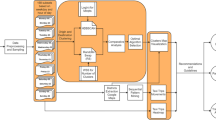Abstract
In order to identify geolocation of defaulter and extract travel information from trajectory data, spatial–temporal grid clustering method are adopted to analysis massive trajectory data. Firstly, the trajectory data are preprocessed, and the spacetime cluster method is applied to detect the travelers’ geolocation information based on the information the travel segments are extracted. Secondly, for the recognition of frequent stay point, we proposed the spatial–temporal grid clustering model with smooth trajectory division algorithm and which improve the efficiency of processing a large amount of trajectory data. Thirdly, we proposed the spatial–temporal grid clustering method based on frequent stay point recognition. The experiment results of stationary trajectory division indicate that the frequent stay point and frequent paths can be effectively excavated under the condition of small information loss. These results demonstrate convincingly the effectiveness of the proposed method.






Similar content being viewed by others
Explore related subjects
Discover the latest articles and news from researchers in related subjects, suggested using machine learning.References
Rodriguez A, Laio A (2014) Clustering by fast search and find of density peaks. Science 344(6191):1492–1496
Ester M, Kriegel H-P, Sander J, Xu X (1996) A density-based algorithm for discovering clusters in large spatial databases with noise. KDD 96:226–231
Schubert E, Sander J, Ester M, Kriegel H-P, Xiaowei X (2017) DBSCAN revisited, revisited: why and how you should (still) use DBSCAN. ACM Trans Database Syst 42(3):19:1-19:21
Mahesh Kumar K, A. Rama Mohan Reddy (2016) A fast DBSCAN clustering algorithm by accelerating neighbor searching using Groups method. Pat Recog 58:39–48
Hao Xue DuQ, Huynh MR (2020) A Location-velocity-temporal attention LSTM model for pedestrian trajectory prediction. IEEE Access 8:44576–44589
Shen L, Stopher PR (2014) Review of GPS travel survey and GPS data-processing methods. Transp Rev 34(3):316–334
Song H, Lee J-G (2018) RP-DBSCAN: a superfast parallel DBSCAN algorithm based on random partitioning. SIGMOD conference 1173–1187
Zimmermann M, Mai T, Frejinger E (2017) Bike route choice modeling using GPS data without choice sets of paths. Transp Res Part C Emerg Technol 75:183–196
Boonchoo T, Ao X, Liu Y, Zhao W, Zhuang F, He Q (2019) Grid-based DBSCAN: indexing and inference. Pat Recogn 90:271–284
Galán SF (2019) Comparative evaluation of region query strategies for DBSCAN clustering. Inf Sci 502:76–90
Zeng Q, Wang J, He K (2020) Improving destination prediction via ensemble of trajectory movement separation and adaptive clustering. IEEE Access 8:28142–28154
Xiao Xu, Ding S, Mingjing Du, Xue Yu (2018) DPCG: an efficient density peaks clustering algorithm based on grid. Int J Mach Learn Cybern 9(5):743–754
Lv Yi, Liu M, Xiang Y (2020) Fast searching density peak clustering algorithm based on shared nearest neighbor and adaptive clustering center. Symmetry 12(12):2014
Zhang Y, Lin Y (2019) An interactive method for identifying the stay points of the trajectory of moving objects. J Vis Commun Image Rep 59:387–392
Rad MH, Abdolrazzagh-Nezhad M (2020) A new hybridization of DBSCAN and fuzzy earthworm optimization algorithm for data cube clustering. Soft Comput 24(20):15529–15549
Chen Y, Zhou L, Bouguila N, Wang C, Chen Y, Du J (2021) BLOCK-DBSCAN: fast clustering for large scale data. Pat Recog 109:107624
Yang Y, Cai J, Yang H, Zhang J, Zhao X (2020) TAD: a trajectory clustering algorithm based on spatial-temporal density analysis. Exp Syst Appl 139
Lei P-R, Li S-C, Peng W-C (2013) QS-STT: QuadSection clustering and spatial-temporal trajectory model for location prediction. Distrib Parallel Databases 31(2):231–258
Hoang H-T, Pham Q-V, Hwang W-J (2020) Spatial-temporal-DBSCAN-based user clustering and power allocation for sum rate maximization in millimeter-wave NOMA systems. Symmetry 12(11):1854
Wang S, Li A, Xie S, Li WenZhu, Wang BoWei, Yao S, Asif M (2021) A spatial-temporal self-attention network (STSAN) for location prediction. CompLex 6692313:1–13
Balcan M-F, Haghtalab N, White C (2020) k-center clustering under perturbation resilience. ACM Trans Algorithms 16(2):22:1-22:39
Hüsch M, Schyska BU, von Bremen L (2020) CorClustST - correlation-based clustering of big spatio-temporal datasets. Futur Gener Comput Syst 110:610–619
Pan Z, Wang Y, Pan Y (2020) A new locally adaptive k-nearest neighbor algorithm based on discrimination class. Knowl Based Syst 204:106185
Zhai J, Qi J, Zhang S (2021) An instance selection algorithm for fuzzy K-nearest neighbor. J Intell Fuzzy Syst 40(1):521–533
Liu L, Donghua Yu (2020) Density peaks clustering algorithm based on weighted k-nearest neighbors and geodesic distance. IEEE Access 8:168282–168296
Acknowledgements
The authors acknowledge the Supported by National Key Research and Development Program of China (2018YFC0830400).
Author information
Authors and Affiliations
Corresponding author
Ethics declarations
Conflict of interest
The authors declare that they have no competing interests.
Additional information
Publisher's Note
Springer Nature remains neutral with regard to jurisdictional claims in published maps and institutional affiliations.
Rights and permissions
About this article
Cite this article
Zhang, B., Wang, Q., Li, J. et al. Spatial–temporal grid clustering method based on frequent stay point recognition. Neural Comput & Applic 34, 9247–9255 (2022). https://doi.org/10.1007/s00521-021-06274-2
Received:
Accepted:
Published:
Issue Date:
DOI: https://doi.org/10.1007/s00521-021-06274-2




